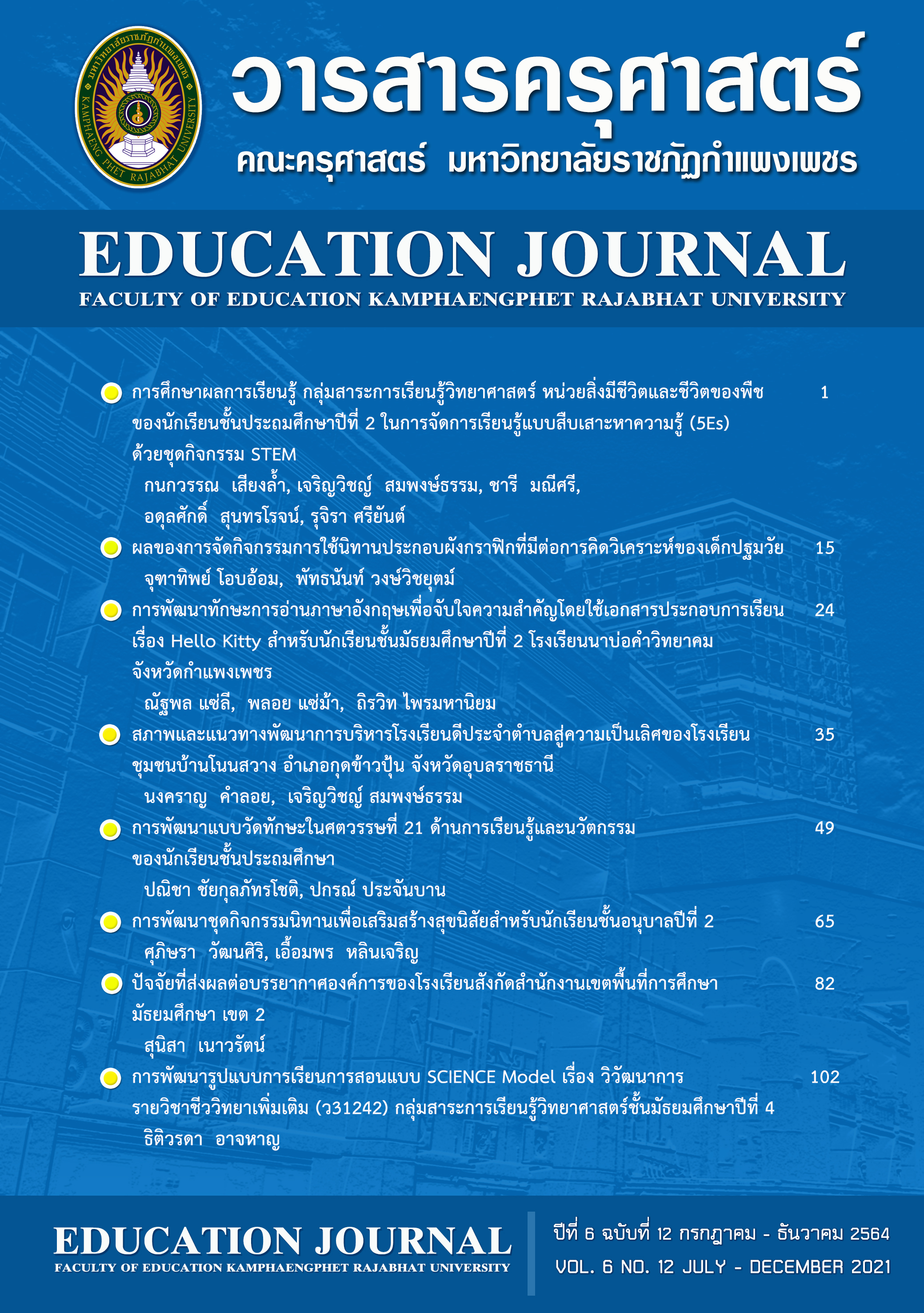THE DEVELOPMENT OF 21st CENTURY SKILL TEST FOR LEARNING AND INNOVATION OF PRIMARY SCHOOL STUDENTS
Main Article Content
Abstract
The purposes of this research were to establish and verify validity, discrimination and reliability of 21st century skills measurement on learning and innovation of primary school students. And to establish normal criteria for assessment. The samples were 359 primary school students under the Kamphaeng Phet Primary Education Service Area Office 2, selected by stratified random sampling. Tools used as a test of 21st century skills in learning and innovation. Analyze validity, discrimination, reliability and Normal Distribution T - Score and Z - Score. The research found that. The developed questionnaire has 3 levels of estimation, divided into 3 components which are in the areas of creativity and innovation: 11 items, critical thinking and problem solving (5 items), communication and cooperation (9 items), a total of 25 items. There are 25 items with content validity with a full score of 50 points. Have an IOC between 0.56 - 0.78. The 25 questions passed by the IOC have found discrimination between 0.32 and 0.76. From the analysis of construct validity, found that, the weight of creative and innovative components is between 0.225-0.412. Critical thinking and problem solving are between 0.454 - 0.543 and communication and cooperation are between 0.313 - 0.443. Reliability is 0.904, which has a high level. With a raw score between 11.0 and 47.0 points with an average score of 30.13 and a standard deviation of 8.228, Normal Distribution T -Score between 26.75 and 70.50 and Z-Score between -2.33 and 2.05. Evaluation criteria are divided into 4 levels. Including very good levels with 37 points or more, good levels with scores between 32 - 36 points, fair levels with scores between 25 - 31 points and improvement levels when there are 24 points down.
Article Details

This work is licensed under a Creative Commons Attribution-NonCommercial 4.0 International License.
CC Attribution-NonCommercial-NoDerivatives 4.0
References
ทิศนา แขมมณี.(2555). ศาสตร์การสอน: องค์ความรู้เพื่อการจัดกระบวนการเรียนรู้ทีมีประสิทธิภาพ. กรุงเทพฯ : จุฬาลงกรณ์มหาวิทยาลัย.
ปกรณ์ ประจันบาน และ อนุชา กอนพ่วง. (2559). การวิจัยและพัฒนาแบบวัดทักษะในศตวรรษที่ 21 ด้านการรู้เท่าทันสื่อของนักเรียนชั้นมัธยมศึกษา. วารสารศึกษาศาสตร์ มหาวิทยาลัยนเรศวร, 18(1), หน้า 144 – 154.
ศิริชัย กาญจนวาสี. (2552). ทฤษฎีการทดสอบแบบดั้งเดิม (พิมพ์ครั้งที่ 6). กรุงเทพฯ: โรงพิมพ์แห่งจุฬาลงกรณ์มหาวิทยาลัย.
สุวรรณา ใจกล้า และจตุภูมิ เขตจัตุรัส. (2562). การพัฒนาชุดเครื่องมือประเมินทักษะการเรียนรู้และนวัตกรรม ตามแนวคิดการประเมินที่ใช้การปฏิบัติเป็นฐาน สำหรับนักเรียนชั้นมัธยมศึกษาตอนปลาย.[Online]. Available : https://app.gs.kku.ac.th/gs/th/publicationfile/item/20th-ngrc-2019/HMO30/HMO30.pdf [5 กรกฎาคม 2563]
สำนักงานคณะกรรมการพัฒนาการเศรษฐกิจและสังคมแห่งชาติ. (2559). แผนพัฒนาเศรษฐกิจและสังคมแห่งชาติฉบับที่ 12 พ.ศ. 2560 – 2564. ม.ป.ท.
ไสว ฟักขาว. (ม.ป.ป.). ทักษะแห่งศตวรรษที่ 21 (21st Century Skills). [Online]. Available : https://web.chandra.ac.th/blog/wp-content/uploads/2015/ทักษะแห่งศตวรรษที่-21-พับ.pdf. [30 มิถุนายน 2563].
Kay, K. (2010). 21st Century Skills: Why the Matter, What they are, and How We Get There. In Bellanca, J. & Brandt, R. (Eds.), 21st Century Skills: Rethinking How Students Learn. Bloomington, In: Solution Tree Press.
Martin, J. (2010). The Meaning of the 21st Century. Bangkok. L. T. P. The Partnership for 21st Century Skill. (2009). Framework for 21st Century Learning. Retrieved June 5, 2015, from http://21st Century skill. Org/index.php.
Partnership for 21st Century Skills (2011). Framework for 21st Century Learning. [Online]. Available : http://www.p21.org/storage/documents/1.__p21_framework_2-pager.pdf. [30 มิถุนายน 2563].

